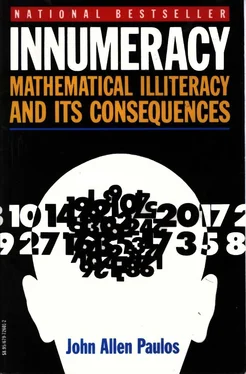John Paulos - INNUMERACY - Mathematical Illiteracy and Its Consequences
Здесь есть возможность читать онлайн «John Paulos - INNUMERACY - Mathematical Illiteracy and Its Consequences» весь текст электронной книги совершенно бесплатно (целиком полную версию без сокращений). В некоторых случаях можно слушать аудио, скачать через торрент в формате fb2 и присутствует краткое содержание. Жанр: Математика, Математика, на английском языке. Описание произведения, (предисловие) а так же отзывы посетителей доступны на портале библиотеки ЛибКат.
- Название:INNUMERACY: Mathematical Illiteracy and Its Consequences
- Автор:
- Жанр:
- Год:неизвестен
- ISBN:нет данных
- Рейтинг книги:5 / 5. Голосов: 1
-
Избранное:Добавить в избранное
- Отзывы:
-
Ваша оценка:
- 100
- 1
- 2
- 3
- 4
- 5
INNUMERACY: Mathematical Illiteracy and Its Consequences: краткое содержание, описание и аннотация
Предлагаем к чтению аннотацию, описание, краткое содержание или предисловие (зависит от того, что написал сам автор книги «INNUMERACY: Mathematical Illiteracy and Its Consequences»). Если вы не нашли необходимую информацию о книге — напишите в комментариях, мы постараемся отыскать её.
Topics include probability and coincidence, the birthday problem, innumeracy in pseudoscience, and statistics and trade-offs in society.
INNUMERACY: Mathematical Illiteracy and Its Consequences — читать онлайн бесплатно полную книгу (весь текст) целиком
Ниже представлен текст книги, разбитый по страницам. Система сохранения места последней прочитанной страницы, позволяет с удобством читать онлайн бесплатно книгу «INNUMERACY: Mathematical Illiteracy and Its Consequences», без необходимости каждый раз заново искать на чём Вы остановились. Поставьте закладку, и сможете в любой момент перейти на страницу, на которой закончили чтение.
Интервал:
Закладка:
Another somewhat uncommon way of obtaining information is the so-called capture-recapture method. Assume we want to know how many fish are in a certain lake. We capture one hundred of them, mark them, and then let them go. After allowing them to disperse about the lake, we catch another hundred fish and see what fraction of them are marked.
If eight of the hundred we capture are marked, then a reasonable estimate of the fraction of marked fish in the whole lake is 8 percent. Since this 8 percent is constituted by the one hundred fish we originally marked, the number of fish in the whole lake can be determined by solving the proportion: 8 (marked fish in the second sampling) is to 100 (the total number of the second sampling) as 100 (the total number marked) is to N (the total number in the lake). N is about 1,250.
Of course, care must be taken that the marked fish don't die as a result of the marking, that they're more or less uniformly distributed about the lake, that the marked ones aren't only the slower or more gullible among the fish, etc. As a way to get a rough estimate, however, the capture-recapture method is effective, and of more generality than the fish example might suggest.
Statistical analyses of works whose authorship is disputed (books of the Bible, The Federalist Papers, etc.) also depend on related clever ways of gleaning information from uncooperative (because dead) sources.
TWO THEORETICAL RESULTS
A large part of the attraction of probability theory is the immediacy and intuitive appeal of its practical problems and of the simple principles which enable us to solve many of them. Still, the following two theoretical results are of such fundamental importance that I'd be derelict were I not to mention them at all.
The first is the law of large numbers, one of the most significant though often misunderstood theorems in probability theory, and one which people sometimes invoke to justify all sorts of bizarre conclusions. It states simply that in the long run the difference between the probability of some event and the relative frequency with which it occurs approaches zero.
In the special case of a fair coin, the law of large numbers, first described by James Bernoulli in 1713, tells us that the difference between 1/ 2and the quotient of the total number of heads obtained divided by the total number of flips can be proved to get arbitrarily close to zero as the number of flips increases. Remember from the discussion on losers and fair coins in Chapter 2 that this doesn't mean that the difference between the total number of heads and the total number of tails will get smaller as the number of flips increases; generally, quite the opposite happens. Fair coins behave well in a ratio sense, but not in an absolute sense. And contrary to countless barroom conversations, the law of large numbers doesn't imply the gambler's fallacy: that a head is more likely after a string of tails.
Among other things the law justifies is the experimenter's belief that the average of a bunch of measurements of some quantity should approach the true value of the quantity as the number of measurements increases. It also provides the rationale for the common-sense observation that if a die is rolled N times, the chances that the number of 5s obtained differs much from N/6 gets smaller and smaller as N gets larger.
Succinctly: The law of large numbers gives a theoretical basis for the natural idea that a theoretical probability is some kind of guide to the real world, to what actually happens.
The normal bell-shaped curve seems to describe many phenomena in nature. Why? Another very important theoretical result in probability theory, the so-called central limit theorem, provides the theoretical explanation for the prevalence of this normal Gaussian distribution (named after Carl Friedrich Gauss, one of the greatest mathematicians of the nineteenth or any other century). The central limit theorem states that the sum (or the average) of a large bunch of measurements follows a normal curve even if the individual measurements themselves do not. What does this mean?
Imagine a factory which produces small batteries for toys, and assume that the factory is run by a sadistic engineer who ensures that about 30 percent of the batteries burn out after only five minutes, and the remaining 70 percent last for approximately a thousand hours before burning out. The distribution of the lifetimes of these batteries is clearly not described by a normal bell-shaped curve, but rather by a U-shaped curve consisting of two spikes, one at five minutes and a bigger one at a thousand hours.
Assume now that these batteries come off the assembly line in random order and are packed in boxes of thirty-six. If we decide to determine the average lifetime of the batteries in a box, we'll find it to be about 700 or so; say, 709. If we determine the average lifetime of the batteries in another box of thirty-six, we'll again find the average lifetime to be about 700 or so, perhaps 687. In fact, if we examine many such boxes, the average of the averages will be very close to 700, and what's more fascinating, the distribution of these averages will be approximately normal (bell-shaped), with the right percentage of packages having averages between 680 and 700, or between 700 and 720, and so on.
The central limit theorem states that under a wide variety of circumstances this will always be the case-averages and sums of nonnormally distributed quantities will nevertheless themselves have a normal distribution.
The normal distribution also arises in the measuring process. Here the theorem provides the theoretical support for the fact that the measurements of any quantity tend to follow a normal bell-shaped "error curve" centered on the true value of the quantity being measured. Other quantities which tend to follow a normal distribution might include age-specific heights and weights, water consumption in a city for any given day, widths of machined parts, I.Q.s (whatever it is that they measure), the number of admissions to a large hospital on any given day, distances of darts from a bull's-eye, leaf sizes, breast sizes, or the amount of soda dispensed by a vending machine. All these quantities can be thought of as the average or sum of many factors (genetic, physical, or social), and thus the central limit theorem explains their normal distribution.
Succinctly: Averages (or sums) of quantities tend to follow a normal distribution even when the quantities of which they're the average (or sum) don't.
CORRELATION AND CAUSATION
Correlation and causation are two quite different words, and the innumerate are more prone to mistake them than most. Quite often, two quantities are correlated without either one being the cause of the other.
One common way in which this can occur is for changes in both quantities to be the result of a third factor. A well-known example involves the moderate correlation between milk consumption and the incidence of cancer in various societies. The correlation is probably explained by the relative wealth of these societies, bringing about both increased milk consumption and more cancer due to greater longevity. In fact, any health practice, such as milk drinking, which correlates positively with longevity will probably do the same with cancer incidence.
There is a small negative correlation between death rates per thousand people in various regions of the country and divorce rates per thousand marriages in the same regions. More divorce, less death. Again, a third factor, the age distribution of the various regions, points toward an explanation. Older married couples are less likely to divorce and more likely to die than younger married couples. In fact, because divorce is such a wrenching, stressful experience, it probably raises one's risk of death, and thus the reality is quite contrary to the above misleading correlation. Another example of a correlation mistaken for a cause: In the New Hebrides Islands, body lice were considered a cause of good health. As in many folk observations, there was some evidence for this. When people took sick, their temperatures rose and caused the body lice to seek more hospitable abodes. The lice and good health both departed because of the fever. Similarly, the correlation between the quality of a state's day-care programs and the reported rate of child sex abuse in them is certainly not causal, but merely indicates that better supervision results in more diligent reporting of the incidents which do occur.
Читать дальшеИнтервал:
Закладка:
Похожие книги на «INNUMERACY: Mathematical Illiteracy and Its Consequences»
Представляем Вашему вниманию похожие книги на «INNUMERACY: Mathematical Illiteracy and Its Consequences» списком для выбора. Мы отобрали схожую по названию и смыслу литературу в надежде предоставить читателям больше вариантов отыскать новые, интересные, ещё непрочитанные произведения.
Обсуждение, отзывы о книге «INNUMERACY: Mathematical Illiteracy and Its Consequences» и просто собственные мнения читателей. Оставьте ваши комментарии, напишите, что Вы думаете о произведении, его смысле или главных героях. Укажите что конкретно понравилось, а что нет, и почему Вы так считаете.












